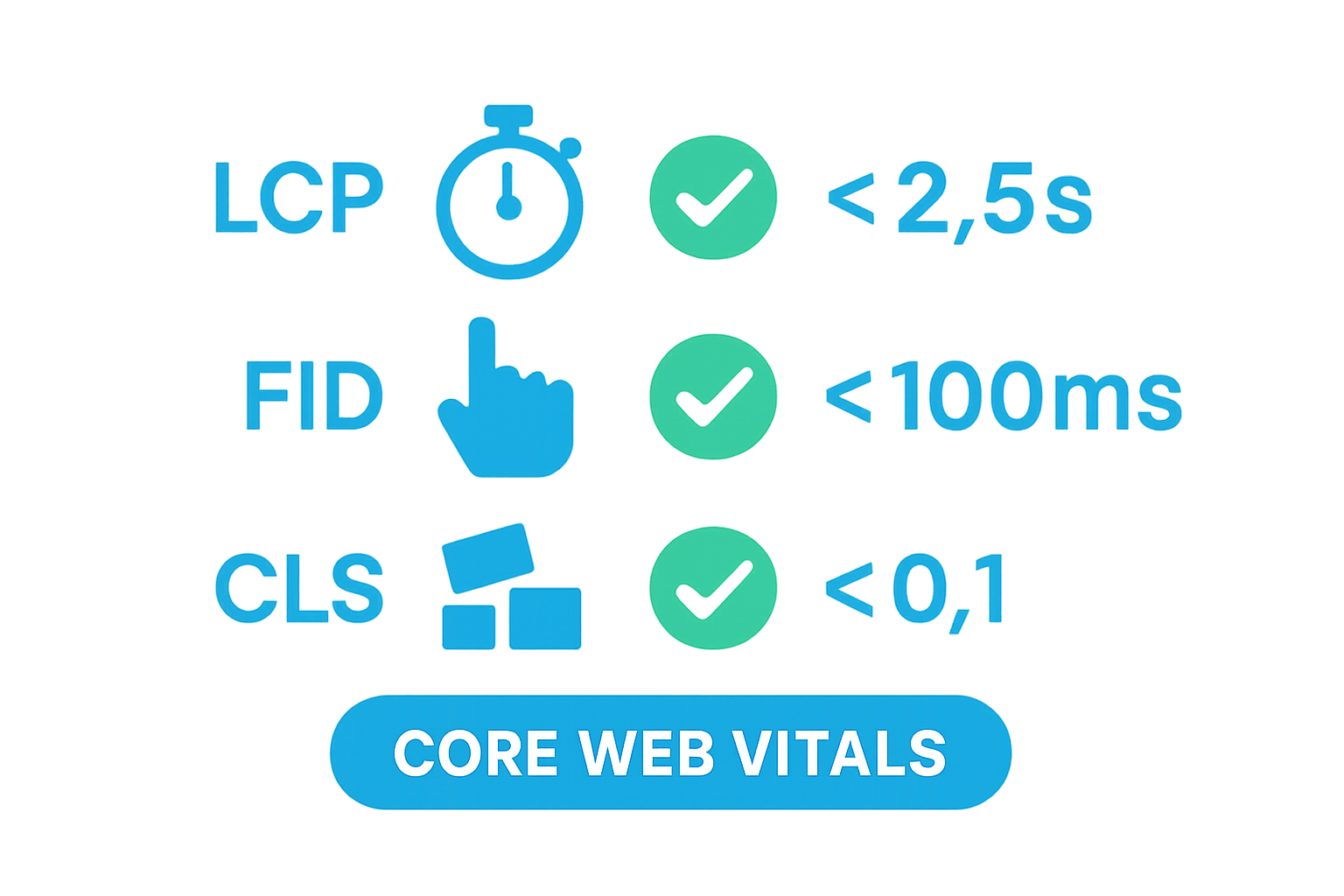Core Web Vitals are changing the way Google ranks sites, focusing on real user experience instead of just keywords or backlinks. Most people know that faster websites perform better, but research shows that sites with good Core Web Vitals see up to a 24 percent reduction in visitor bounce rates. It might sound like a complicated technical checklist, yet the real story is how these metrics reveal what keeps visitors engaged and coming back for more.
Table of Contents
- What Are Core Web Vitals And Their Role In SEO?
- Why Core Web Vitals Are Important For Website Performance
- How Core Web Vitals Affect User Experience And Engagement
- Key Metrics Of Core Web Vitals: LCP, FID, CLS Explained
- Real-World Impact Of Core Web Vitals On SEO Success
Quick Summary
| Takeaway | Explanation |
|---|---|
| Core Web Vitals are crucial for SEO. | Google uses these metrics to determine search rankings and user experience evaluations. |
| Focus on LCP, FID, and CLS metrics. | Largest Contentful Paint, First Input Delay, and Cumulative Layout Shift are essential for optimal web performance. |
| Improve user experience to boost engagement. | Faster load times and responsive designs lead to lower bounce rates and higher conversion rates. |
| Visual stability enhances user trust. | Reducing unexpected layout shifts keeps users engaged and maintains a professional site appearance. |
| Invest in Core Web Vitals for competitive advantage. | Meeting these standards can significantly elevate your website’s visibility and user retention. |
What Are Core Web Vitals and Their Role in SEO?
Core Web Vitals represent a critical set of user experience metrics that Google uses to evaluate website performance and determine search rankings. These metrics go beyond traditional SEO factors by measuring how real users interact with and perceive a website’s loading speed, interactivity, and visual stability.
Understanding the Core Components
Google defines three primary Core Web Vitals that every website owner should understand:
- Largest Contentful Paint (LCP): Measures how quickly the main content of a webpage loads. An ideal LCP should occur within 2.5 seconds of when the page first starts loading.
- First Input Delay (FID): Evaluates the website’s interactivity by measuring the time between a user’s first interaction (like clicking a button) and the browser’s response. A good FID is less than 100 milliseconds.
- Cumulative Layout Shift (CLS): Assesses visual stability by tracking unexpected layout movements during page load. A good CLS score is less than 0.1, ensuring elements don’t jump around unpredictably.
SEO Impact and Ranking Significance
Core Web Vitals have become a crucial ranking factor in Google’s algorithm since May 2021. Research from Google’s web performance team demonstrates that websites meeting these metrics provide superior user experiences, directly influencing search rankings.
By prioritizing these metrics, website owners can not only improve their search engine positioning but also create more engaging and user-friendly digital experiences.
For those looking to dive deeper into technical optimization, our guide on understanding technical SEO provides comprehensive insights into improving website performance.
Website owners should recognize that Core Web Vitals are not just technical checkboxes but fundamental indicators of user experience. A site that loads quickly, responds instantly, and maintains visual stability will naturally attract and retain more visitors, ultimately supporting better SEO performance.
Below is a table summarizing the Core Web Vitals metrics, their purpose, and Google’s recommended thresholds to help you quickly understand their role in optimizing user experience and SEO.
| Metric | What It Measures | Recommended Benchmark |
|---|---|---|
| Largest Contentful Paint (LCP) | Loading speed of main page content | Occurs within 2.5 seconds |
| First Input Delay (FID) | Time for browser to respond to first user interaction | Less than 100 milliseconds |
| Cumulative Layout Shift (CLS) | Visual stability and unexpected content movement during loading | Less than 0.1 |
Why Core Web Vitals Are Important for Website Performance
Core Web Vitals represent more than just technical metrics. They are fundamental indicators of user experience that directly impact a website’s success in attracting and retaining visitors. By focusing on these critical performance measurements, website owners can create digital experiences that not only satisfy search engine algorithms but also meet user expectations.
User Experience and Search Performance
Search engines like Google prioritize websites that deliver exceptional user experiences. Core Web Vitals provide a quantifiable framework for assessing how well a website performs from a user perspective. Poor performance in these metrics can significantly reduce a site’s visibility and search rankings, making them crucial for digital success.
Economic and Engagement Implications
The impact of Core Web Vitals extends far beyond search rankings. Websites that optimize these metrics experience tangible benefits:
- Reduced Bounce Rates: Faster, more responsive websites keep users engaged and reduce the likelihood of visitors leaving immediately.
- Improved Conversion Rates: Smooth, stable web experiences encourage users to complete desired actions like purchases or sign-ups.
- Enhanced User Satisfaction: Websites that load quickly and respond instantly create positive user perceptions and build brand trust.
Competitive Digital Positioning
Research from Google’s web performance team indicates that websites meeting Core Web Vitals metrics provide superior user experiences. By proactively addressing these performance indicators, businesses can gain a competitive edge in an increasingly digital marketplace. For those seeking to optimize their digital strategy, our guide on landing page optimization offers additional insights into creating high-performing web experiences.
Ultimately, Core Web Vitals are not just technical requirements but strategic tools for creating websites that truly connect with and serve users effectively.
How Core Web Vitals Affect User Experience and Engagement
Core Web Vitals are more than technical metrics. They represent a comprehensive approach to understanding how users interact with websites, measuring critical aspects of digital experience that directly influence user satisfaction, engagement, and ultimately, business success.
Psychological Impact of Website Performance
User experience is fundamentally about perception and emotional response. Websites that load slowly or display unstable content create negative psychological friction, making users feel frustrated and impatient. When a webpage takes more than three seconds to load, users are likely to abandon the site, resulting in lost opportunities for engagement and conversion.
Measuring User Interaction Quality
Core Web Vitals provide quantifiable insights into user interaction quality through three primary metrics:
- Perceived Loading Speed (Largest Contentful Paint): Users feel more confident and engaged when content appears quickly and completely.
- Interactivity Responsiveness (First Input Delay): Instant response to user actions creates a sense of control and seamless interaction.
- Visual Stability (Cumulative Layout Shift): Preventing unexpected content movements reduces user disorientation and maintains trust.
Engagement and Conversion Dynamics
Research from the International Web Association demonstrates that optimized Core Web Vitals directly correlate with improved user engagement. Websites that prioritize these metrics not only retain users more effectively but also increase the likelihood of conversions. For digital strategists looking to dive deeper into user experience optimization, our guide on personalization and SEO offers additional strategic insights.
By understanding and implementing Core Web Vitals, businesses transform their websites from mere digital platforms into responsive, user-centric experiences that anticipate and fulfill user expectations.
Key Metrics of Core Web Vitals: LCP, FID, CLS Explained
Core Web Vitals represent a sophisticated system for measuring website performance, providing website owners and developers with precise tools to understand and improve user experience. These metrics act as digital performance indicators, offering insights into how users perceive and interact with web pages.
Understanding Performance Metrics
Core Web Vitals assess three critical dimensions of web performance, each representing a unique aspect of user interaction. These metrics transform abstract user experience concepts into measurable, actionable data points that directly impact search rankings and user satisfaction.
The Three Fundamental Metrics
Each Core Web Vital metric provides a specific lens into website performance:

- Largest Contentful Paint (LCP): Measures loading performance by tracking how quickly the main content of a page becomes visible. An ideal LCP occurs within 2.5 seconds, signaling a fast and responsive website.
- First Input Delay (FID): Evaluates interactivity by measuring the time between a user’s first interaction and the website’s response. A good FID is less than 100 milliseconds, indicating a highly responsive digital experience.
- Cumulative Layout Shift (CLS): Assesses visual stability by tracking unexpected content movements during page load. A low CLS score (under 0.1) ensures that page elements remain consistent, preventing user frustration.
Technical Insights and Performance Optimization
Research from the Web Almanac demonstrates that these metrics are more than technical measurements. They represent a comprehensive approach to understanding user experience. For developers seeking deeper technical optimization strategies, our guide on technical SEO provides additional insights into improving website performance.
By mastering these Core Web Vitals metrics, websites can create more engaging, responsive, and user-friendly digital experiences that not only satisfy users but also align with search engine ranking requirements.
Real-World Impact of Core Web Vitals on SEO Success
Core Web Vitals have transformed from theoretical performance metrics to tangible drivers of digital success. These metrics provide a concrete framework for understanding how website performance directly influences search rankings, user engagement, and ultimately, business outcomes.
Performance as a Competitive Advantage
Websites that consistently meet Core Web Vitals standards gain a significant competitive edge in the digital marketplace. Search engines increasingly prioritize user experience, meaning that technical performance is no longer just a backend concern but a critical business strategy. Companies investing in these metrics see measurable improvements in search visibility and user retention.
Quantifiable Business Implications
The impact of Core Web Vitals extends beyond search rankings into critical business metrics:
- Conversion Rate Enhancement: Faster, more stable websites directly correlate with higher conversion rates, reducing user abandonment and increasing potential revenue.
- User Trust and Credibility: Websites that load quickly and respond smoothly build user confidence, establishing a professional and reliable digital presence.
- Reduced Bounce Rates: Optimal performance keeps users engaged, decreasing the likelihood of users leaving the site prematurely.
SEO and User Experience Convergence
Research examining SERP features and organic click-through rates demonstrates that technical performance is increasingly intertwined with search success. For digital strategists seeking to understand this intersection more deeply, our guide on semantic search strategies offers comprehensive insights into modern SEO approaches.
By recognizing Core Web Vitals as more than technical checkboxes, businesses can transform their digital platforms into high-performing, user-centric experiences that not only rank well but genuinely satisfy user needs.

Unlock the Full Power of Core Web Vitals With RankAligner
Struggling to turn Core Web Vitals insights into lasting SEO results? If your website loads slowly or has unpredictable shifts, users leave before taking action. Unoptimized performance places your hard-earned rankings and conversions at risk. The article explained the importance of metrics like LCP, FID, and CLS in creating a fast, stable, and interactive site. But knowing what Core Web Vitals are is only half the battle. You need reliable, actionable tools to maintain your SEO edge and prevent technical errors from sabotaging your rankings.
Take control of your website health today. Trust RankAligner, the #1 keyword cannibalization tool trusted by SEO professionals, to keep your pages clear of performance blockers and keyword confusion. Discover how quickly you can resolve technical SEO pain points and protect your traffic gains. Visit our landing page to learn how you can maintain Core Web Vitals excellence while avoiding cannibalization risks. Make each visit count by optimizing your entire SEO process with tools built for consultants and agencies. The longer you wait, the more opportunities slip away. Start now and elevate your rankings before your competitors do.
Frequently Asked Questions
What are Core Web Vitals?
Core Web Vitals are a set of specific user experience metrics defined by Google that assess a website’s loading speed, interactivity, and visual stability. The three main metrics are Largest Contentful Paint (LCP), First Input Delay (FID), and Cumulative Layout Shift (CLS).
Why are Core Web Vitals important for SEO?
Core Web Vitals are important for SEO because they directly impact how Google ranks websites. Sites that meet these performance metrics offer better user experiences, which can lead to higher rankings in search results.
How can I improve my website’s Core Web Vitals scores?
To improve Core Web Vitals scores, optimize your website by enhancing loading speeds (LCP), decreasing the time it takes for the browser to respond to user interactions (FID), and ensuring visual stability during page loads (CLS). Techniques include optimizing images, using efficient caching, and minimizing JavaScript.
What are the ideal scores for Core Web Vitals metrics?
The ideal scores for Core Web Vitals are: Largest Contentful Paint (LCP) should occur within 2.5 seconds, First Input Delay (FID) should be less than 100 milliseconds, and Cumulative Layout Shift (CLS) should be less than 0.1. Meeting these benchmarks indicates a good user experience.

